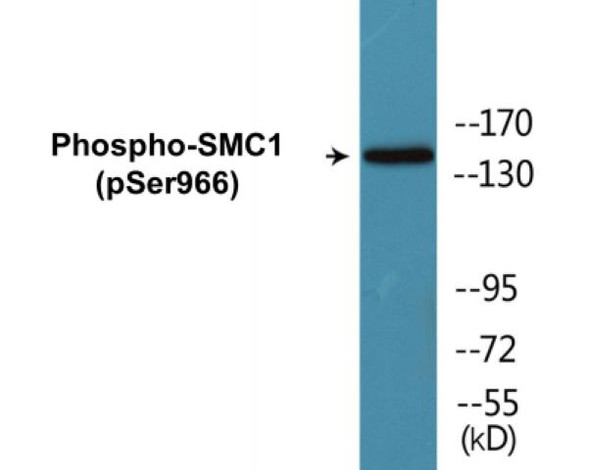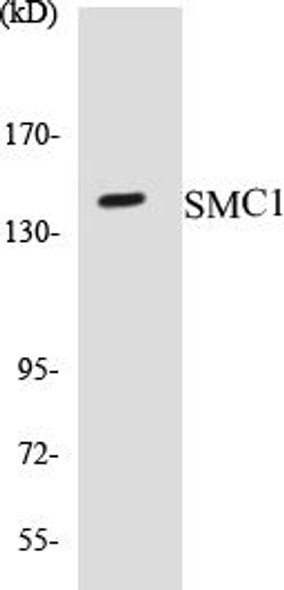Description
SMC1 (Phospho-Ser957)Colorimetric Cell-Based ELISA Kit
The SMC1 Phospho-Ser957 Colorimetric Cell-Based ELISA Kit is specifically designed for the accurate detection of phosphorylated SMC1 protein at serine 957 in cell lysates. This kit offers high sensitivity and specificity, allowing for reliable and reproducible results in a variety of research applications.SMC1, a subunit of the cohesin complex, plays a crucial role in DNA repair, chromosome segregation, and gene expression regulation. Phosphorylation of SMC1 at serine 957 is known to be involved in cell cycle progression and response to DNA damage.
Therefore, studying the phosphorylation status of SMC1 can provide valuable insights into cellular processes and disease mechanisms.By utilizing this kit, researchers can gain a better understanding of the role of phosphorylated SMC1 in various cellular pathways and diseases, including cancer, genetic disorders, and aging. With its user-friendly protocol and reliable performance, the SMC1 Phospho-Ser957 Colorimetric Cell-Based ELISA Kit is a valuable tool for studying the complex dynamics of SMC1 phosphorylation in cellular signaling pathways.
| Product Name: | SMC1 (Phospho-Ser957) Colorimetric Cell-Based ELISA |
| Product Code: | CBCAB01606 |
| ELISA Type: | Cell-Based |
| Target: | SMC1 (Phospho-Ser957) |
| Reactivity: | Human, Mouse |
| Dynamic Range: | > 5000 Cells |
| Detection Method: | Colorimetric 450 nm |
| Format: | 2 x 96-Well Microplates |
The SMC1 (Phospho-Ser957) Colorimetric Cell-Based ELISA Kit is a convenient, lysate-free, high throughput and sensitive assay kit that can detect SMC1 protein phosphorylation and expression profile in cells. The kit can be used for measuring the relative amounts of phosphorylated SMC1 in cultured cells as well as screening for the effects that various treatments, inhibitors (ie. siRNA or chemicals), or activators have on SMC1 phosphorylation.
Qualitative determination of SMC1 (Phospho-Ser957) concentration is achieved by an indirect ELISA format. In essence, SMC1 (Phospho-Ser957) is captured by SMC1 (Phospho-Ser957)-specific primary (1ø) antibodies while the HRP-conjugated secondary (2ø) antibodies bind the Fc region of the 1ø antibody. Through this binding, the HRP enzyme conjugated to the 2ø antibody can catalyze a colorimetric reaction upon substrate addition. Due to the qualitative nature of the Cell-Based ELISA, multiple normalization methods are needed:
| 1. | A monoclonal antibody specific for human GAPDH is included to serve as an internal positive control in normalizing the target absorbance values. |
| 2. | Following the colorimetric measurement of HRP activity via substrate addition, the Crystal Violet whole-cell staining method may be used to determine cell density. After staining, the results can be analysed by normalizing the absorbance values to cell amounts, by which the plating difference can be adjusted. |
| Database Information: | Gene ID: 8243, UniProt ID: Q14683, OMIM: 300040/300590, Unigene: Hs.211602 |
| Gene Symbol: | SMC1A |
| Sub Type: | Phospho |
| UniProt Protein Function: | Involved in chromosome cohesion during cell cycle and in DNA repair. Central component of cohesin complex. The cohesin complex is required for the cohesion of sister chromatids after DNA replication. The cohesin complex apparently forms a large proteinaceous ring within which sister chromatids can be trapped. At anaphase, the complex is cleaved and dissociates from chromatin, allowing sister chromatids to segregate. The cohesin complex may also play a role in spindle pole assembly during mitosis. Involved in DNA repair via its interaction with BRCA1 and its related phosphorylation by ATM, or via its phosphorylation by ATR. Works as a downstream effector both in the ATM/NBS1 branch and in the ATR/MSH2 branch of S-phase checkpoint. |
| NCBI Summary: | Proper cohesion of sister chromatids is a prerequisite for the correct segregation of chromosomes during cell division. The cohesin multiprotein complex is required for sister chromatid cohesion. This complex is composed partly of two structural maintenance of chromosomes (SMC) proteins, SMC3 and either SMC1B or the protein encoded by this gene. Most of the cohesin complexes dissociate from the chromosomes before mitosis, although those complexes at the kinetochore remain. Therefore, the encoded protein is thought to be an important part of functional kinetochores. In addition, this protein interacts with BRCA1 and is phosphorylated by ATM, indicating a potential role for this protein in DNA repair. This gene, which belongs to the SMC gene family, is located in an area of the X-chromosome that escapes X inactivation. Mutations in this gene result in Cornelia de Lange syndrome. Alternative splicing results in multiple transcript variants encoding different isoforms. [provided by RefSeq, Jul 2013] |
| UniProt Code: | Q14683 |
| NCBI GenInfo Identifier: | 29336622 |
| NCBI Gene ID: | 8243 |
| NCBI Accession: | Q14683.2 |
| UniProt Secondary Accession: | Q14683,O14995, Q16351, Q2M228, |
| UniProt Related Accession: | Q14683 |
| Molecular Weight: | 155 kDa |
| NCBI Full Name: | Structural maintenance of chromosomes protein 1A |
| NCBI Synonym Full Names: | structural maintenance of chromosomes 1A |
| NCBI Official Symbol: | SMC1A |
| NCBI Official Synonym Symbols: | SMC1; SMCB; CDLS2; SB1.8; SMC1L1; DXS423E; SMC1alpha |
| NCBI Protein Information: | structural maintenance of chromosomes protein 1A |
| UniProt Protein Name: | Structural maintenance of chromosomes protein 1A |
| UniProt Synonym Protein Names: | Sb1.8 |
| Protein Family: | Structural maintenance of chromosomes protein |
| UniProt Gene Name: | SMC1A |
| Component | Quantity |
| 96-Well Cell Culture Clear-Bottom Microplate | 2 plates |
| 10X TBS | 24 mL |
| Quenching Buffer | 24 mL |
| Blocking Buffer | 50 mL |
| 15X Wash Buffer | 50 mL |
| Primary Antibody Diluent | 12 mL |
| 100x Anti-Phospho Target Antibody | 60 µL |
| 100x Anti-Target Antibody | 60 µL |
| Anti-GAPDH Antibody | 60 µL |
| HRP-Conjugated Anti-Rabbit IgG Antibody | 12 mL |
| HRP-Conjugated Anti-Mouse IgG Antibody | 12 mL |
| SDS Solution | 12 mL |
| Stop Solution | 24 mL |
| Ready-to-Use Substrate | 12 mL |
| Crystal Violet Solution | 12 mL |
| Adhesive Plate Seals | 2 seals |
The following materials and/or equipment are NOT provided in this kit but are necessary to successfully conduct the experiment:
- Microplate reader able to measure absorbance at 450 nm and/or 595 nm for Crystal Violet Cell Staining (Optional)
- Micropipettes with capability of measuring volumes ranging from 1 µL to 1 ml
- 37% formaldehyde (Sigma Cat# F-8775) or formaldehyde from other sources
- Squirt bottle, manifold dispenser, multichannel pipette reservoir or automated microplate washer
- Graph paper or computer software capable of generating or displaying logarithmic functions
- Absorbent papers or vacuum aspirator
- Test tubes or microfuge tubes capable of storing ≥1 ml
- Poly-L-Lysine (Sigma Cat# P4832 for suspension cells)
- Orbital shaker (optional)
- Deionized or sterile water
*Note: Protocols are specific to each batch/lot. For the correct instructions please follow the protocol included in your kit.
| Step | Procedure |
| 1. | Seed 200 µL of 20,000 adherent cells in culture medium in each well of a 96-well plate. The plates included in the kit are sterile and treated for cell culture. For suspension cells and loosely attached cells, coat the plates with 100 µL of 10 µg/ml Poly-L-Lysine (not included) to each well of a 96-well plate for 30 minutes at 37 °C prior to adding cells. |
| 2. | Incubate the cells for overnight at 37 °C, 5% CO2. |
| 3. | Treat the cells as desired. |
| 4. | Remove the cell culture medium and rinse with 200 µL of 1x TBS, twice. |
| 5. | Fix the cells by incubating with 100 µL of Fixing Solution for 20 minutes at room temperature. The 4% formaldehyde is used for adherent cells and 8% formaldehyde is used for suspension cells and loosely attached cells. |
| 6. | Remove the Fixing Solution and wash the plate 3 times with 200 µL 1x Wash Buffer for five minutes each time with gentle shaking on the orbital shaker. The plate can be stored at 4 °C for a week. |
| 7. | Add 100 µL of Quenching Buffer and incubate for 20 minutes at room temperature. |
| 8. | Wash the plate 3 times with 1x Wash Buffer for 5 minutes each time. |
| 9. | Add 200 µL of Blocking Buffer and incubate for 1 hour at room temperature. |
| 10. | Wash 3 times with 200 µL of 1x Wash Buffer for 5 minutes each time. |
| 11. | Add 50 µL of 1x primary antibodies Anti-SMC1 (Phospho-Ser957) Antibody, Anti-SMC1 Antibody and/or Anti-GAPDH Antibody) to the corresponding wells, cover with Parafilm and incubate for 16 hours (overnight) at 4 °C. If the target expression is known to be high, incubate for 2 hours at room temperature. |
| 12. | Wash 3 times with 200 µL of 1x Wash Buffer for 5 minutes each time. |
| 13. | Add 50 µL of 1x secondary antibodies (HRP-Conjugated AntiRabbit IgG Antibody or HRP-Conjugated Anti-Mouse IgG Antibody) to corresponding wells and incubate for 1.5 hours at room temperature. |
| 14. | Wash 3 times with 200 µL of 1x Wash Buffer for 5 minutes each time. |
| 15. | Add 50 µL of Ready-to-Use Substrate to each well and incubate for 30 minutes at room temperature in the dark. |
| 16. | Add 50 µL of Stop Solution to each well and read OD at 450 nm immediately using the microplate reader. |
(Additional Crystal Violet staining may be performed if desired – details of this may be found in the kit technical manual.)






